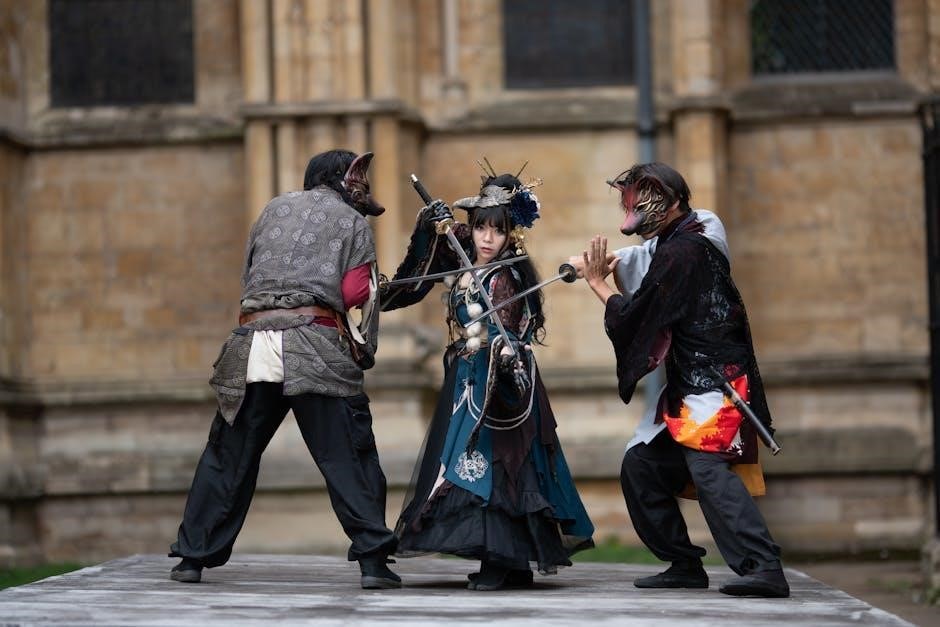The Fight Club screenplay, written by Jim Uhls and directed by David Fincher, is a cult classic exploring themes of rebellion and toxic masculinity. Its iconic dialogue and subversive storytelling have made it a cornerstone of modern cinema, with fans worldwide downloading the Fight Club script PDF for analysis and inspiration.
1.1 Overview of the Screenplay’s Background
The Fight Club screenplay, adapted from Chuck Palahniuk’s novel, was written by Jim Uhls and directed by David Fincher. Released in 1999, the film stars Edward Norton, Brad Pitt, and Helena Bonham Carter. It explores themes of toxic masculinity, consumerism, and rebellion, resonating deeply with audiences. The screenplay’s non-linear structure and subversive storytelling set it apart, making it a study in modern cinematic technique. Fans and writers often download the Fight Club script PDF to analyze its iconic dialogue, character development, and pacing, which have cemented its legacy as a cult classic.
1.2 Importance of the Fight Club Script in Modern Cinema
The Fight Club screenplay holds significant importance in modern cinema for its bold exploration of themes like toxic masculinity, consumerism, and rebellion. Its subversive storytelling and non-linear structure have influenced contemporary filmmakers and writers. The script’s iconic dialogue and complex characters, such as Tyler Durden, have become cultural touchstones. Many aspiring screenwriters study the Fight Club script PDF to learn about pacing, character development, and thematic depth. Its ability to spark conversations about societal issues ensures its relevance, making it a cornerstone of modern cinematic study and inspiration for creators worldwide.
1.3 Key Themes and Messages in the Screenplay
The Fight Club screenplay delves into themes of toxic masculinity, consumerism, and rebellion, critiquing modern society’s emphasis on materialism. It explores identity crises, as seen in the narrator’s struggle with anonymity and the rise of Tyler Durden. The script also examines the consequences of societal conformity and the human need for connection. These themes are conveyed through iconic dialogue and a non-linear narrative, making the screenplay a powerful commentary on contemporary issues. The availability of the Fight Club script PDF has allowed writers to study its structure and messaging, ensuring its relevance in sparking conversations about individuality and societal norms.
The Origin and Adaptation of Fight Club
Fight Club originated from Chuck Palahniuk’s novel, adapted into a screenplay by Jim Uhls. Directed by David Fincher, it became a cultural phenomenon, blending dark humor with rebellion. The Fight Club screenplay PDF captures this journey, offering insights into its iconic dialogue and subversive themes, making it a timeless study for writers and filmmakers alike.
2.1 The Novel by Chuck Palahniuk
Chuck Palahniuk’s 1996 novel Fight Club is a dark, subversive exploration of modern masculinity and consumer culture. The story follows an unnamed narrator suffering from insomnia and existential crisis, who forms a fight club with the enigmatic Tyler Durden. Palahniuk’s prose is raw and provocative, delving into themes of rebellion, identity, and societal critique. The novel’s success led to its adaptation into a screenplay by Jim Uhls, directed by David Fincher, cementing its place in pop culture. The Fight Club screenplay PDF reflects the novel’s edgy tone and philosophical depth, making it a timeless study for writers and filmmakers.
2.2 The Screenwriting Process by Jim Uhls
Jim Uhls’ adaptation of Chuck Palahniuk’s novel into the Fight Club screenplay was a meticulous process, capturing the story’s dark humor and subversive themes. Uhls faced challenges in translating the novel’s complex narrative structure and unreliable narrator into a cohesive script. He emphasized maintaining the edgy tone and philosophical depth while ensuring cinematic viability. The screenplay’s success lies in its ability to balance dialogue, action, and introspection, making it a study piece for writers. The Fight Club screenplay PDF remains a valuable resource, offering insights into Uhls’ masterful adaptation and its impact on modern storytelling.
2.3 David Fincher’s Vision for the Film
David Fincher’s direction brought the Fight Club screenplay to life with a dark, gritty aesthetic, emphasizing themes of rebellion and toxic masculinity. Fincher’s meticulous attention to detail and visual style transformed the narrative into a cinematic experience. His use of non-linear storytelling and intense performances from Edward Norton and Brad Pitt captured the essence of the script. Fincher’s vision amplified the film’s subversive tone, making it a cultural phenomenon. The Fight Club screenplay PDF reflects his collaborative approach, blending Jim Uhls’ script with his own artistic interpretation to create a timeless critique of modern society.

Plot Breakdown and Analysis
The Fight Club screenplay follows an unnamed narrator’s descent into chaos, forming a subversive fight club with Tyler Durden, exploring themes of rebellion and identity through its dark, non-linear narrative.
3.1 The Narrator’s Journey and Identity Crisis
The narrator, an unnamed insomniac office worker, embodies a profound identity crisis, feeling disconnected from modern society. His journey begins with emotional numbness, seeking solace in support groups. As he meets Marla, his inner turmoil deepens, leading to the creation of Tyler Durden, his alter ego. This duality symbolizes his rebellion against societal expectations, exploring themes of masculinity and self-destruction. The screenplay masterfully portrays his descent into chaos, blending dark humor with philosophical introspection, making his transformation one of cinema’s most compelling character arcs.
3.2 The Formation of Fight Club
Fight Club emerges as a raw, underground phenomenon, born from the narrator’s frustration with modern society. The first fight between the narrator and Tyler Durden sparks a cathartic release, attracting disillusioned men seeking escape from consumerism. Initially a therapeutic outlet, Fight Club evolves into a subversive movement, challenging societal norms. Its growth is fueled by a sense of camaraderie and rebellion, with members embracing chaos as a form of liberation. The club’s rules, particularly the emphasis on secrecy, highlight its anti-establishment ethos, transforming it into a cultural phenomenon that resonates deeply with its audience.

3.3 The Rise of Tyler Durden
Tyler Durden’s ascent begins as a manifestation of the narrator’s fractured psyche, evolving into a charismatic leader who embodies rebellion. His influence grows as he manipulates the narrator and others, fostering a sense of purpose among disillusioned men. Tyler’s ideology of rejecting societal norms and embracing chaos resonates deeply, turning Fight Club into a cult-like movement. His control intensifies, overshadowing the narrator and propelling the story toward its dark climax. Tyler’s rise symbolizes the dangerous allure of anti-establishment ideals, making him one of cinema’s most iconic and complex antagonists.
3.4 The Twist Ending and Its Implications
The twist ending reveals that the narrator and Tyler Durden are the same person, shattering the audience’s perception of reality. This revelation forces a reevaluation of the entire narrative, as the line between illusion and truth blurs. The ending underscores themes of identity fragmentation and mental instability, while its ambiguity leaves viewers questioning the outcome. The twist not only shocks but also deepens the film’s exploration of societal alienation and rebellion. It cements Fight Club as a groundbreaking story, challenging audiences to confront the darker aspects of human nature and the consequences of unchecked rebellion.
Character Development
The screenplay masterfully explores the evolution of its characters, delving deeply into themes of identity, rebellion, and societal critique through their interactions and development.
4.1 The Narrator: A Study in Anonymity
The narrator, often unnamed, embodies modern alienation, struggling with identity and purpose. His internal monologue reveals deep societal disillusionment, driving his descent into chaos. Through his voiceover, the screenplay delves into his psyche, exposing his consumerist frustrations and existential crisis. His anonymity symbolizes the facelessness of contemporary life, while his actions reflect a desperate search for meaning. The narrator’s journey from passivity to rebellion, alongside Tyler Durden, underscores themes of identity fragmentation and rebellion against societal norms, making him a compelling yet tragic figure in the story’s exploration of masculinity and rebellion.

4.2 Tyler Durden: The Symbol of Rebellion
Tyler Durden emerges as the narrator’s charismatic yet volatile alter ego, embodying rebellion against societal norms. His ideologies of rejecting consumerism and embracing primal instincts captivate the narrator and others, fueling the creation of Fight Club. Tyler’s enigmatic presence and bold actions symbolize a rejection of modern conformity, making him a powerful figure of defiance. His influence over the narrator and the underground movement highlights themes of toxic masculinity and rebellion, cementing his role as a central symbol of resistance in the screenplay.
4.3 Marla Singer: The Enigmatic Female Lead

Marla Singer, portrayed by Helena Bonham Carter, is a mysterious and self-destructive character who becomes entangled in the narrator’s chaotic world. Her dark humor, emotional detachment, and penchant for danger make her a fascinating yet unsettling figure. Marla’s relationship with the narrator and Tyler Durden adds depth to the story, as she challenges their identities and motivations. Her presence serves as a catalyst for the narrator’s downward spiral, blending into the themes of rebellion and existential crisis. Marla’s enigmatic nature makes her a pivotal yet unpredictable element in the screenplay’s exploration of modern societal disillusionment.
4.4 The Support Groups: A Reflection of Society
The support groups in Fight Club serve as a microcosm of societal dysfunction, highlighting themes of emotional detachment and consumerism. The narrator attends a testicular cancer support group, where he finds temporary solace in shared suffering. These groups symbolize a search for meaning in a hyper-consumerist world, where individuals struggle to connect. The raw emotion and vulnerability displayed in these scenes contrast with the superficiality of modern life, mirroring the broader societal alienation. The support groups also underscore the narrator’s internal turmoil, setting the stage for his rebellion and the rise of Tyler Durden.
Iconic Dialogue and Quotes
The Fight Club screenplay is renowned for its unforgettable lines, such as “You are not a beautiful and unique snowflake” and “The first rule of Fight Club.” These quotes encapsulate the film’s rebellious spirit and critique of modern society, resonating deeply with audiences and becoming ingrained in pop culture. The narrator’s internal monologue and Tyler Durden’s philosophical musings add layers of complexity, making the dialogue both provocative and thought-provoking.
5.1 The Most Memorable Lines from the Script
The Fight Club screenplay is packed with iconic dialogue that has become deeply ingrained in pop culture. Lines like “You are not a beautiful and unique snowflake” and “The first rule of Fight Club is: you do not talk about Fight Club” are endlessly quoted. Tyler Durden’s monologues, such as “It’s only after we’ve lost everything that we’re free to do anything,” capture the essence of rebellion and existential crisis. These memorable quotes not only define the film’s themes but also resonate with audiences, making the script a timeless study in subversive storytelling and philosophical provocation.
5.2 The Philosophy of Tyler Durden
Tyler Durden’s philosophy, as depicted in the Fight Club screenplay, revolves around rebellion against modern society’s consumerist culture. He advocates for liberation from societal expectations, embracing chaos as a form of freedom. His iconic lines, such as “It’s only after we’ve lost everything that we’re free to do anything,” encapsulate his belief in rejecting materialism and embracing primal instincts. Durden’s philosophy critiques the emptiness of contemporary life, urging individuals to break free from conformity and redefine their purpose. His ideas resonate deeply, making him a symbol of anti-establishment thought and a catalyst for radical change in the narrator’s journey.
5.3 The Narrator’s Internal Monologue
The narrator’s internal monologue in the Fight Club screenplay serves as a window into his psyche, revealing his deep-seated frustrations and existential crises. His voiceover narration provides insight into his feelings of alienation, consumerist disillusionment, and the search for identity. Through his thoughts, the audience witnesses his transformation from a passive, unnamed everyman to a radical collaborator in Tyler Durden’s chaotic world. The monologue underscores his internal conflict, blending dark humor with philosophical musings, creating a complex and relatable character. This narrative device is crucial in exploring themes of rebellion and self-discovery, making the narrator’s journey both personal and universally resonant.

Themes and Symbolism
The Fight Club screenplay explores themes of toxic masculinity, consumerism, and rebellion, using symbolism to critique modern society. The narrator’s journey reflects these themes through vivid, often disturbing imagery.
6.1 Toxic Masculinity and Its Critique
The Fight Club screenplay delves into toxic masculinity through the narrator’s identity crisis and the rise of Tyler Durden. Tyler embodies hyper-masculinity, promoting aggression and dominance, critiquing societal expectations of male behavior. The film uses fight clubs and Project Mayhem to explore themes of male rebellion against emasculation, highlighting the dangers of unchecked masculinity. This critique is central to the narrative, offering a dark reflection of modern societal pressures and the search for identity in a consumerist world.
6.2 Consumerism and Modern Society
The Fight Club screenplay sharply critiques consumerism, portraying a society obsessed with materialism and superficiality. The narrator, trapped in a corporate job, exemplifies the emptiness of modern life, where identity is defined by possessions. Tyler Durden’s rebellion, through acts like Project Mayhem, symbolizes a violent rejection of consumer culture. The film highlights how societal pressures to conform and consume lead to alienation and spiritual decay. By destroying symbols of consumerism, the characters seek liberation, reflecting a broader commentary on the suffocating effects of capitalist culture and the search for authenticity in a hyper-materialistic world.
6.3 Rebellion Against Conformity

The Fight Club screenplay delves into the theme of rebellion against societal norms, showcasing characters who reject conformity. Tyler Durden emerges as a symbol of resistance, challenging the monotony of modern life. The narrator’s journey reflects a desire to break free from the constraints of societal expectations, embracing chaos over order. Through the formation of fight clubs and Project Mayhem, the story critiques the passive acceptance of cultural norms, advocating for individuality and autonomy. This rebellion is not just physical but ideological, urging viewers to question and resist the suffocating grip of conformity in a hyper-consumerist world.
6.4 The Use of Symbolism in the Screenplay
The Fight Club screenplay is rich in symbolism, with elements like the narrator’s apartment and the fight clubs themselves serving as metaphors for societal critique. The narrator’s condo, filled with meaningless consumer goods, symbolizes modern life’s emptiness. Tyler Durden’s emergence represents rebellion against conformity, while the color palette of dark tones and muted hues reflects the bleakness of contemporary existence. The constant use of fire and destruction symbols signifies a desire to purge societal constructs. These symbols collectively create a layered narrative, inviting viewers to interpret deeper meanings behind the chaos and anarchy portrayed in the story.

The Screenplay’s Structure and Style
The Fight Club screenplay employs a non-linear narrative with flashbacks, voiceover narration, and tight pacing to build tension and immerse the audience in its chaotic world.
7.1 Non-Linear Narrative and Flashbacks
The Fight Club screenplay masterfully employs a non-linear narrative, weaving together fragmented flashbacks to mirror the narrator’s fractured psyche. This structure builds suspense and heightens the twist ending’s impact, as key events are revealed out of chronological order. The use of flashbacks seamlessly integrates the formation of Tyler Durden and the narrator’s identity crisis, creating a layered storytelling experience. This unconventional approach keeps audiences engaged and underscores the film’s themes of rebellion and chaos, making the screenplay a standout example of innovative narrative design in modern cinema.
7.2 The Use of Voiceover Narration
The Fight Club screenplay heavily relies on voiceover narration to delve into the narrator’s internal world, offering a unique perspective on his thoughts and emotions. This technique allows the audience to connect deeply with the protagonist’s psyche, creating a sense of intimacy and immediacy. The voiceover often contrasts with the external chaos, providing insight into the narrator’s motivations and inner turmoil. Iconic lines delivered through voiceover, such as “I am Jack’s…” have become synonymous with the film’s identity. The narration also serves to build suspense and foreshadow key events, making it a crucial element in the screenplay’s structure and style.
7.3 Pacing and Tension Building
The Fight Club screenplay masterfully employs pacing to build tension, oscillating between slow, introspective moments and explosive, chaotic sequences. The formation of Fight Club and the rise of Tyler Durden are expertly timed to escalate tension, keeping audiences engaged. Dialogue and visual descriptions in the script heighten suspense, particularly in scenes like the narrator’s breakdown and the project mayhem initiation. The narrative’s unpredictability, coupled with its non-linear structure, ensures a gripping experience. Fincher’s direction amplifies these elements, creating a cinematic thrill that culminates in the film’s shocking climax, leaving a lasting impact on viewers.
Cultural Impact and Controversy
The Fight Club screenplay sparked intense debates, challenging societal norms and inspiring pop culture. Its controversial themes led to both acclaim and backlash, cementing its influence.
8.1 The Film’s Reception and Public Reaction
The release of Fight Club in 1999 sparked polarized reactions. Critics initially debated its violent themes and dark humor, while audiences were divided between admiration and outrage. Despite this, the film gradually gained a cult following, with its subversive message resonating deeply with many viewers. The screenplay’s exploration of toxic masculinity and rebellion struck a chord, leading to widespread discussions. Over time, Fight Club became a cultural phenomenon, solidifying its place as a provocative and influential work in modern cinema.
8.2 The Influence of Fight Club on Pop Culture
Fight Club has left an indelible mark on pop culture, inspiring countless references in music, fashion, and social media. Its iconic quotes and themes of rebellion have been widely quoted and parodied. The film’s anti-consumerist message and exploration of toxic masculinity have influenced artists, designers, and writers. Tyler Durden’s charismatic persona has become a cultural symbol, while the film’s dark humor and subversive style continue to resonate with audiences. Fight Club‘s impact is evident in its enduring popularity, making it a timeless piece of cinematic art that challenges societal norms and sparks conversations.
8.3 The Screenplay’s Role in Sparking Conversations
The Fight Club screenplay has become a catalyst for meaningful discussions, challenging audiences to reflect on societal norms and personal identity. Its exploration of toxic masculinity, consumerism, and rebellion resonates deeply, sparking debates about modern culture. The script’s availability as a Fight Club screenplay PDF has made it accessible for analysis, inspiring writers and filmmakers to explore subversive storytelling. Its themes of rebellion and self-discovery continue to provoke thought, making it a timeless piece that fuels conversations about individuality and societal expectations. The screenplay’s impact lies in its ability to challenge and inspire, ensuring its relevance in contemporary discourse.

Resources for Aspiring Screenwriters
The Fight Club screenplay PDF is a valuable resource for writers, offering insights into subversive storytelling and iconic character development. Analyzing the script provides lessons in pacing, dialogue, and themes, while its availability online makes it accessible for study. Aspiring screenwriters can download the Fight Club script to explore its structure and style, gaining inspiration for their own projects. It remains a timeless tool for learning the craft of screenwriting and understanding modern cinematic storytelling techniques.
9.1 Where to Download the Fight Club Screenplay PDF
The Fight Club screenplay PDF is widely available online for aspiring screenwriters. Websites like Studiovity and No Film School offer free downloads, providing access to the iconic script. Fans and writers can also find it on various screenwriting forums and repositories. The PDF includes the full transcript, iconic quotes, and character breakdowns, making it a valuable resource for studying subversive storytelling and dialogue. Downloading the script allows for in-depth analysis of its structure, pacing, and themes, offering insights into the craft of screenwriting and the film’s enduring influence on modern cinema.
9.2 Analyzing the Script for Writing Lessons
Analyzing the Fight Club screenplay PDF offers invaluable writing lessons. The script’s non-linear storytelling, voiceover narration, and pacing showcase masterful narrative techniques. Its iconic dialogue and character development provide insights into crafting compelling characters like Tyler Durden. The screenplay’s exploration of themes such as toxic masculinity and rebellion highlights the importance of layered storytelling. By studying the script, writers can learn how to engage audiences with subversive ideas and complex characters, making it a must-study resource for understanding modern screenwriting and its impact on cinema.
9.3 Screenwriting Tips Inspired by Fight Club
The Fight Club screenplay PDF offers valuable screenwriting lessons. Its non-linear structure and unreliable narrator showcase innovative storytelling techniques. Writers can learn from its use of flashbacks and voiceover to build suspense. The script’s iconic dialogue, particularly Tyler Durden’s monologues, demonstrates how to craft memorable lines that resonate with audiences. Additionally, the film’s pacing and tension-building highlight the importance of balancing slow-burn narratives with explosive moments. By studying these elements, aspiring screenwriters can gain insights into creating complex characters, subversive themes, and narratives that provoke thought and spark conversations about societal issues.
Conclusion
The Fight Club screenplay PDF remains a powerful tool for writers, offering timeless lessons in subversive storytelling and character development. Its influence continues to resonate, inspiring new voices in cinema while challenging societal norms and sparking essential conversations about identity and rebellion.
10.1 The Lasting Legacy of the Fight Club Screenplay

The Fight Club screenplay has cemented its place as a modern classic, influencing filmmakers and writers globally. Its exploration of toxic masculinity, consumerism, and rebellion continues to resonate, making it a staple in cinematic studies. The Fight Club script PDF is widely downloaded for its iconic dialogue and subversive storytelling techniques, offering invaluable lessons for aspiring screenwriters. Its ability to provoke thought and challenge societal norms ensures its relevance, solidifying its legacy as a groundbreaking work in contemporary cinema.
10.2 Final Thoughts on Its Relevance Today
The Fight Club screenplay remains strikingly relevant, offering sharp commentary on modern societal issues. Its critique of consumerism and exploration of identity crises continue to resonate with audiences. The Fight Club script PDF serves as a powerful tool for understanding subversive storytelling and character development. Its influence is evident in pop culture, inspiring new generations of writers and filmmakers. The screenplay’s ability to spark conversations about toxic masculinity and rebellion ensures its enduring impact, making it a timeless piece of cinematic literature.
